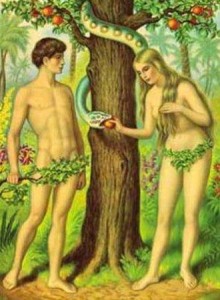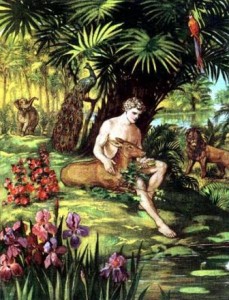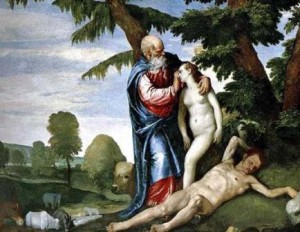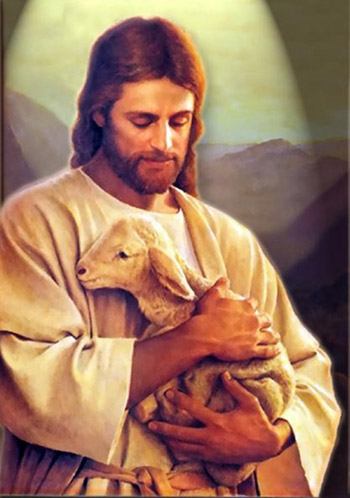மூலம்: ரிச்சர்ட் ஷேனிக் (Richard Schoenig)
தமிழில்: ஆர்.கோபால்
மொழிபெயர்ப்பாளர் முன்னுரை:
இந்தக் கட்டுரை கிறிஸ்துவ மதத்தைப் பற்றியது. இது ஏன் இங்கே ‘தமிழ்ஹிந்து‘வில் பிரசுரிக்கப்படவேண்டும் என்ற கேள்வி எழலாம்.
 தமிழ்நாட்டில் பரவியுள்ள கிறிஸ்துவ இஸ்லாமியக் கலாசாரத்தின் விளைவாக பல இந்துக்களும் ஆதாம் ஏவாள் கொள்கையை நம்புபவர்களாக இருக்கிறார்கள். முதல் பாவம் என்பது கவிதைகளிலும் கதைகளிலும் சினிமாக்களிலும் பேசப்படுகிறது. முதல் மனிதர்களைக் குறிக்க ஆதாம் ஏவாள் என்ற பெயர்கள் பொதுவாகப் புழங்கும் பெயர்களாக ஆகிவிட்டன. “முதல் பாவம்” என்ற பெயரில் ஓர் ஆபாசத் திரைப்படம் எடுக்கப்பட்டு வெளியிடப்படுகிறது. பரவலாகிவிட்ட இந்த யூதப் பழங்குடியினரின் புராணக் கதையை பெரும்பாலான நம் மக்கள் நம்பவில்லை என்றாலும், ஏதோ ஒரு ரீதியில் ஆதிமனிதனைக் குறிக்க இந்தச் சொற்கள் புழக்கத்தில் வந்துவிட்டன. இந்த முதல் பாவக் கொள்கை காரணமாகவே தெருமுனைகளிலும் தொலைக்காட்சி பெட்டிகளிலும் பல்வேறு கிறிஸ்துவப் பிரசாரகர்கள், “பாவிகளே!…” என்று நம்மைப் பார்த்துக் கத்துகிறார்கள். அவர்கள் உலகத்தில் உள்ள அனைவரையும்- ஒரு பாவமும் செய்யாத பச்சை குழந்தையிலிருந்து மகாத்மா காந்தி வரை எல்லோரையும்- பாவிகள் என்று ஏன் சொல்கிறார்கள் என்று நாம் அறிந்துகொள்வது தேவையான ஒன்று.
தமிழ்நாட்டில் பரவியுள்ள கிறிஸ்துவ இஸ்லாமியக் கலாசாரத்தின் விளைவாக பல இந்துக்களும் ஆதாம் ஏவாள் கொள்கையை நம்புபவர்களாக இருக்கிறார்கள். முதல் பாவம் என்பது கவிதைகளிலும் கதைகளிலும் சினிமாக்களிலும் பேசப்படுகிறது. முதல் மனிதர்களைக் குறிக்க ஆதாம் ஏவாள் என்ற பெயர்கள் பொதுவாகப் புழங்கும் பெயர்களாக ஆகிவிட்டன. “முதல் பாவம்” என்ற பெயரில் ஓர் ஆபாசத் திரைப்படம் எடுக்கப்பட்டு வெளியிடப்படுகிறது. பரவலாகிவிட்ட இந்த யூதப் பழங்குடியினரின் புராணக் கதையை பெரும்பாலான நம் மக்கள் நம்பவில்லை என்றாலும், ஏதோ ஒரு ரீதியில் ஆதிமனிதனைக் குறிக்க இந்தச் சொற்கள் புழக்கத்தில் வந்துவிட்டன. இந்த முதல் பாவக் கொள்கை காரணமாகவே தெருமுனைகளிலும் தொலைக்காட்சி பெட்டிகளிலும் பல்வேறு கிறிஸ்துவப் பிரசாரகர்கள், “பாவிகளே!…” என்று நம்மைப் பார்த்துக் கத்துகிறார்கள். அவர்கள் உலகத்தில் உள்ள அனைவரையும்- ஒரு பாவமும் செய்யாத பச்சை குழந்தையிலிருந்து மகாத்மா காந்தி வரை எல்லோரையும்- பாவிகள் என்று ஏன் சொல்கிறார்கள் என்று நாம் அறிந்துகொள்வது தேவையான ஒன்று.
மற்றொன்று, பரவலாக இருக்கும் கிறிஸ்துவ, இஸ்லாமியத் தொலைக்காட்சிகளில் வெளிநாட்டினரும் நம்மக்களில் சிலரும் இந்த ஆதாம் ஏவாள் கதையை, தொடர்ந்து பிரசாரம் செய்துவருகின்றார்கள். இதனால், ஒரு சில இந்துப் பொதுமக்கள் ஆதம் ஏவாள் என்பவர்கள் இவர்கள் சொல்வது போல கடவுளால் 6000 வருடங்களுக்கு முன்னால் படைக்கப்பட்டவர்கள் என்று நம்புகிறார்கள். இது இந்து மதக் கொள்கை அல்ல. மாறாக, இந்து மதப் புத்தகங்களின்படி, இந்தப் பிரபஞ்சம், வயது கணக்கிட முடியாத அளவு புராதனமானது. ஒவ்வொரு யுகமும் பல லட்சம் வருடங்கள் கொண்டது. கிரித யுகம், திரேதா யுகம், த்வாபர யுகம், கலியுகம் ஆகியவை பருவகாலங்கள் போல சுழற்சியாக வருகின்றன. இந்த நான்கு யுகங்களும் சேர்ந்து ஒரு சதுர்யுகமாகிறது. 71 சதுர்யுகங்கள் கொண்டது ஒரு மன்வந்தரம் என்று சொல்லப்படுகிறது. (ஒரு கிரித யுகத்தின் அளவு 1728000 வருடங்கள்).
கார்ல் சாகன் (Dr. Carl Sagan, 1934-1996) என்ற புகழ்பெற்ற வானவியல் இயற்பியலாளர் தனதுகாஸ்மோஸ் (cosmos) என்ற புத்தகத்தில், கூறுகிறார்:
இந்தப் பிரபஞ்சமும் இது போன்ற எண்ணற்ற அனந்த அனந்தப் (infinite) பிரபஞ்சங்களும் பிரம்மத்தில் முகிழ்த்து மறைகின்றன என்று வேதங்கள் கூறுகின்றன. எல்லாக் காலங்களுக்கும் வெளிகளுக்கும் அப்பாலும் அதனுள் உறைந்தும் பிரம்மம் இருக்கிறது என்று வேதங்கள் கூறுகின்றன. எண்ணற்ற பிரம்மாக்கள் எண்ணற்ற பிரபஞ்சங்களை உருவாக்கியவண்ணம் இருக்கிறார்கள். தங்கள் காலம் முடிந்ததும் அந்த பிரம்மாக்கள் மறைந்து புதிய பிரம்மாக்கள் பிறக்கிறார்கள் என்று இந்து மதம் உரைக்கிறது. பிரம்மத்துக்குள் ஒடுங்கியுள்ளது வெளிப்படுகிறது என்று இந்து மதப் புத்தகங்கள் உரைக்கின்றன. ஆகவே ஆதாம் ஏவாள் என்ற சிறுபிள்ளைக்கதையை நாம் நம்புவது தவறு.
அறிவியற்பூர்வமாகவும் ஆதாம் ஏவாள் என்ற மனிதர்கள் இல்லை. தொடர்ந்து மாறிவரும் பரிணாமத்தில் இதுவரை குரங்கு, இதற்குப் பிள்ளை மனிதன் என்று சொல்வதும் தவறு. மேலும் பல்வேறு அறிவியல்களில் ஒன்றான பரிணாமவியலை கிறிஸ்துவமோ அல்லது இஸ்லாமோ ஒப்புக்கொள்வதும் இல்லை. ஆகவே பரிணாமவியலின்படி ஒருவரை மனிதன் என்று சொன்னாலும் அது ஆதாம் அல்லது ஏவாள் என்று கிறிஸ்துவமும் இஸ்லாமும் ஒப்புகொள்வதில்லை. ஏனெனில் பைபிள் சொல்லும் யாஹ்வே என்னும் தெய்வத்தால் களிமண்ணிலிருந்து படைக்கப்பட்டாலே ஆதாம். பரிணாமவியலின்படி தோன்றும் மனிதன் ஆதாம் அல்ல.
நமது இந்து மதப் புத்தகங்களுக்கும் அறிவியலுக்கும் புறம்பான, இப்படிப்பட்ட தவறான கருத்துகளை, ஊடகங்களின் இடைவிடாத பொய்ப் பிரசாரங்களின் காரணமாக இந்துக்களான நாம் உண்மையெனக் கருதிவிடக்கூடாது ஆகவே இந்தக் கட்டுரை, தொடர்ந்து ஒலித்துகொண்டு வரும் இப்படிப்பட்ட யூதப் பழங்குடி மக்களின் புராணக்கதைகளை வரலாறு என கருதிவிடக்கூடாது என்பதற்காகவும் இந்துக்கள் தெளிவு பெற வேண்டும் என்பதற்காகவும் மொழிபெயர்க்கப்பட்டதே அன்றி, கிறிஸ்துவ மதத்தின், அல்லது இஸ்லாமிய மதத்தின் கருத்துகளை விமர்சிக்க வேண்டும் என்பதற்காக எழுதப்பட்டது அல்ல.)
1. முன்னுரை
கிறிஸ்துவ மதத்தில் [1] முதல் பாவம் என்ற கொள்கை (doctrine of original sin (DOS)) உள்ளது. இந்தக் கொள்கையை கிறிஸ்துவத்தின் அடிப்படைக் கொள்கையாக கிறிஸ்துவம் கருதுகிறது. இது“மெல்லவும் முடியாத, துப்பவும் முடியாத” கொள்கை. இந்தக் கொள்கையை வைத்துகொண்டும் கிறிஸ்துவத்தால் இருக்கமுடியாது. தூக்கி எறிந்துவிடவும் முடியாது. இக்கட்டுரையில், முதல் பாவம் நடந்திருக்கமுடியாதது; ஒழுக்க ரீதியில் தவறானது என்று காட்டியதோடு, கிறிஸ்துவத்தால் இதனை வைத்துகொள்ளவும்முடியாது என்று சுட்டிக்காட்டுகிறேன். ஆனால், அதே வேளையில்,2000 வருடங்களாக இதனை கிறிஸ்துவத்தோடு இறுக்கிப் பிணைத்துவிட்டபடியால், இதனைத் தூக்கி எறிவது கிறிஸ்துவ மதத்துக்கே ஆபத்தாகவும் ஆகும் என்றும் காட்டுகிறேன்.
2. முதல் பாவக் கொள்கை என்றால் என்ன?
1. மத்திய தரைக்கடல் (mediterranean sea) பகுதியில் வாழ்ந்துவந்த பழங்குடியினரான யூதர்கள், தங்கள் புராணக்கதைகளை, எல்லாப் பழங்குடியினர் போலவே எழுதிவைத்தனர். பூமி எப்படி உண்டாயிற்று, மனிதன் எப்படி உண்டானான் ஆகிய கதைகளை இவர்கள் மற்ற ஆப்பிரிக்க, அமெரிக்கப் பழங்குடியினர் போலவே கற்பனை செய்து எழுதினார்கள். பின்னர் இவர்களிலிருந்து கிளைத்த ஒரு கிளைமதம் கிறிஸ்துவம் என்ற பெயரில் மெல்ல மெல்ல பரவியது. ரோம அரசால் தத்தெடுத்துகொள்ளப்பட்ட பின்னர் அந்த சாம்ராஜ்யத்தின் வழித்தோன்றல்களாக உருவான ஐரோப்பிய நாடுகளாலும் உலகெங்கும் பரப்பப்பட்டு இந்தப் பழங்குடிப் புராணக்கதைகள் வரலாறு போலப் பிதற்றப்பட்டன. இந்த முதல் பாவம் என்ற கொள்கை இவர்களது ஜெனஸிஸ் எனப்படும்ஆதியாகமம் என்ற பகுதியிலிருந்து எடுக்கப்பட்டது.
 யாஹ்வே என்ற தெய்வம் உலகத்தை உருவாக்கியதாம், பிறகு ஆரம்ப ஆண், பெண் ஜோடியை உருவாக்கியதாம். இந்த ஜோடியை தான் உருவாக்கிய ஒரு தோட்டத்தில் வைத்ததாம். அந்தத் தோட்டத்தில் பலவித விலங்குகளும், செடி கொடி தாவரங்களையும் உருவாக்கிவைத்திருந்ததாம். இந்தச் சமயத்தில் ஆதாமும் ஏவாளும் சாகாவரம் பெற்றவர்களாகவும், வலி, துயரம் ஆகியவை அண்டாதவர்களாகவும் இருந்தார்களாம். அந்தத் தோட்டத்தில் அவர்கள் சுற்றித்திரிய அனுமதித்திருந்தாலும், அறிவு மரத்தின் (Tree of the Knowledge of Good and Evil) கனியை மட்டும் சாப்பிடக்கூடாது என்று சொல்லி, அதனைச் சாப்பிட்டால் உடனே மரணமடைவார்கள் என்றும் எச்சரித்ததாம். பேசும் பாம்பு (இது லூசிபர் என்னும் சாத்தானாம்) இவர்களைத் தூண்டிவிட, இவர்கள் அந்த மரத்தின் கனியைச் சாப்பிட்டார்களாம். கிறிஸ்துவ மதத்தில் உள்ளவர்கள் இதனை மனிதனின் முதல் ஒழுக்கக்கேடு என்றும், முதல் பாவம் என்றும், இதனால், மனிதனின் வீழ்ச்சி உருவானது என்றும் கூறுவார்கள். யாஹ்வே (இதனைத்தான் கர்த்தர் என்று கிறிஸ்துவர்கள் தமிழில் கூறுவார்கள்.) இந்த ஜோடியை தனது தோட்டத்திலிருந்து வெளியே அனுப்பி வலி, துயரம், கடின வாழ்க்கை, இறுதியில் சாவு என்று வாழும்படிக்கு தண்டித்ததாம். (தோட்டம் வானத்தில் இல்லை. பூமியில்தான் இருக்கிறது. அவர்கள் திரும்பவும் உள்ளே வந்துவிடக்கூடாது என்பதற்காக தோட்ட வாசலில் தேவதைகள் காவல் வேறு இருக்கிறார்களாம்.)
யாஹ்வே என்ற தெய்வம் உலகத்தை உருவாக்கியதாம், பிறகு ஆரம்ப ஆண், பெண் ஜோடியை உருவாக்கியதாம். இந்த ஜோடியை தான் உருவாக்கிய ஒரு தோட்டத்தில் வைத்ததாம். அந்தத் தோட்டத்தில் பலவித விலங்குகளும், செடி கொடி தாவரங்களையும் உருவாக்கிவைத்திருந்ததாம். இந்தச் சமயத்தில் ஆதாமும் ஏவாளும் சாகாவரம் பெற்றவர்களாகவும், வலி, துயரம் ஆகியவை அண்டாதவர்களாகவும் இருந்தார்களாம். அந்தத் தோட்டத்தில் அவர்கள் சுற்றித்திரிய அனுமதித்திருந்தாலும், அறிவு மரத்தின் (Tree of the Knowledge of Good and Evil) கனியை மட்டும் சாப்பிடக்கூடாது என்று சொல்லி, அதனைச் சாப்பிட்டால் உடனே மரணமடைவார்கள் என்றும் எச்சரித்ததாம். பேசும் பாம்பு (இது லூசிபர் என்னும் சாத்தானாம்) இவர்களைத் தூண்டிவிட, இவர்கள் அந்த மரத்தின் கனியைச் சாப்பிட்டார்களாம். கிறிஸ்துவ மதத்தில் உள்ளவர்கள் இதனை மனிதனின் முதல் ஒழுக்கக்கேடு என்றும், முதல் பாவம் என்றும், இதனால், மனிதனின் வீழ்ச்சி உருவானது என்றும் கூறுவார்கள். யாஹ்வே (இதனைத்தான் கர்த்தர் என்று கிறிஸ்துவர்கள் தமிழில் கூறுவார்கள்.) இந்த ஜோடியை தனது தோட்டத்திலிருந்து வெளியே அனுப்பி வலி, துயரம், கடின வாழ்க்கை, இறுதியில் சாவு என்று வாழும்படிக்கு தண்டித்ததாம். (தோட்டம் வானத்தில் இல்லை. பூமியில்தான் இருக்கிறது. அவர்கள் திரும்பவும் உள்ளே வந்துவிடக்கூடாது என்பதற்காக தோட்ட வாசலில் தேவதைகள் காவல் வேறு இருக்கிறார்களாம்.)
 அவர்களுடைய தண்டனையில், அவர்கள் பாவம் செய்ய இயற்கையிலேயே விருப்பமுள்ளவர்களாகவும், தங்களைத் தாங்களாகவே அந்தத் தண்டனையிலிருந்து மீட்டுகொள்ள முடியாதவர்களாவும் மனிதர்களை ஆக்கியதும் சேர்த்தியாம். கூடவே, அவர்களது தண்டனை அவர்களுக்கு மட்டுமல்ல, அவர்களது குழந்தைகளுக்கும் சந்ததிகளுக்கும் மேலேயேயும் இருக்குமாம்; கூடவே மிருகங்களுக்கும் இந்த தண்டனை கொடுக்கப்பட்டுவிட்டதாம். (மிருகங்கள் செய்யாத தவறுக்கு மிருகங்களுக்கும் தண்டனை!)
அவர்களுடைய தண்டனையில், அவர்கள் பாவம் செய்ய இயற்கையிலேயே விருப்பமுள்ளவர்களாகவும், தங்களைத் தாங்களாகவே அந்தத் தண்டனையிலிருந்து மீட்டுகொள்ள முடியாதவர்களாவும் மனிதர்களை ஆக்கியதும் சேர்த்தியாம். கூடவே, அவர்களது தண்டனை அவர்களுக்கு மட்டுமல்ல, அவர்களது குழந்தைகளுக்கும் சந்ததிகளுக்கும் மேலேயேயும் இருக்குமாம்; கூடவே மிருகங்களுக்கும் இந்த தண்டனை கொடுக்கப்பட்டுவிட்டதாம். (மிருகங்கள் செய்யாத தவறுக்கு மிருகங்களுக்கும் தண்டனை!)
உலகம் உருவானது எப்படி என்று யூதர்களது பழங்குடிக் கதை போன்றே ஒவ்வொரு பழங்குடிகளிலும் ஒரு கதை உண்டு. அவற்றை இந்தச் சுட்டியில் காணலாம் . அந்தப் பழங்குடிக் கதைகளைப் பிரசாரம் செய்ய, பெரிய கூட்டம் உங்களை தெருமுனைகளில் சந்தித்து பாவிகளே என்று கதறவில்லை என்பதால் அதனைப் பற்றிப் படிப்பதோடு நிறுத்திக்கொள்ளலாம்.
 இதற்கு மேல் உபரிச் செய்திகளாக இந்த கிறிஸ்துவ மதத்தின் அடிப்படைக் கருதுகோள்களை நினைவுப்படுத்திக்கொள்வது நல்லது. அதாவது ஆறாயிரம் ஆண்டுகளுக்கு முன்னால், யாஹ்வே தெய்வம் உலகத்தையும் வானத்தையும் படைத்து அதில் ஆண் பெண் இருவரையும் படைத்து அவர்கள் கீழ்ப்படியாததால், அவர்களின் சந்ததிகளுக்கும் மிருகங்களுக்கும் முதல் பாவத்தைக் கொடுத்தது. இந்த முதல் பாவம் எல்லோர் மேலும் இருக்கிறது. அந்த முதல் பாவத்தை போக்க யாஹ்வே தெய்வம் ஒரு வழியைச் சிந்தித்தது. அது தனக்குத் தானே ஒரு பலி கொடுத்துக்கொள்வதாக முடிவு செய்ததாம். யூதர்களின் பழைய ஏற்பாட்டில் யாஹ்வே தெய்வத்துக்கு, களங்கமில்லாத ஆடு பலி கொடுக்கப்பட்டால் சந்தோஷமாகி, பலி கொடுத்தவரின் பாவங்களை மன்னிக்கிறதாம். ஆகவே இப்போது களங்கமே இல்லாத ஒரு மனிதனை தனக்குப் பலிகொடுப்பதன் மூலம் யாஹ்வே சந்தோஷமடைந்து பொதுமக்களின் முதல் பாவத்தை மன்னிக்குமாம். ஆகவே இயேசு கிறிஸ்து என்ற தன் மகனைப் பிறக்கவைத்து, தவறே செய்யாத அவரைக் கொலைசெய்து, அதன் மூலம் சந்தோஷமடைந்து, பொதுமக்களின் பாவங்களை மன்னிக்கிறதாம். முன்பு பலி கொடுக்கப்பட்ட ஆட்டின் ரத்தத்தையும் சதையையும் யூதர்கள் புசிப்பார்கள். அதனால்தான் கிறிஸ்துவத்தில், பலி கொடுக்கப்பட்ட இயேசுவின் ரத்தத்தையும் சதையையும் சர்ச்சுகளில் புசிப்பதாகக் கூறிக்கொள்கிறார்கள். ஆனால் ஒரு நிபந்தனை. அப்பாவியான இயேசு கொலை செய்யப்பட்டதால் எல்லோருடைய பாவங்களும் போய்விடாதாம். இயேசு கிறிஸ்து என்பவர் பாவங்களை மன்னிக்க யாஹ்வேயால் அனுப்பப்பட்டார் என்று நம்புபவர் மட்டுமே முதல் பாவத்திலிருந்து மீட்கப்படுவாராம். இதனால்தான் தெரு மூலைகளில் நின்று பாவிகளே என்று நம்மைப் பார்த்துக் கத்தி, இயேசுவை நாம் நம்பவேண்டும் என்று சொல்லுகிறார்கள். இயேசுவும் இந்த உலகத்தில் பிறந்தபோது மேரியிடமிருந்து அவருக்கு முதல் பாவம் ஒட்டியிருக்குமே என்ற கேள்விக்கு, மேரியின் வயிற்றில் இயேசு கருவாக வரும்போது முதல் பாவத்தின் தீட்டு தீண்டாவில்லை என்று எழுதிகொண்டார்கள். ஏன் தீண்டவில்லை என்பதற்கு காரணமெல்லாம் இல்லை. தீண்டவில்லை; அவ்வளவுதான். அதற்கு ஒரு பெயர் வைத்துகொண்டார்கள். அது முதல் பாவம் தீண்டாத கருவடைதல் என்ற பொருளில் immaculate conception of Mary.
இதற்கு மேல் உபரிச் செய்திகளாக இந்த கிறிஸ்துவ மதத்தின் அடிப்படைக் கருதுகோள்களை நினைவுப்படுத்திக்கொள்வது நல்லது. அதாவது ஆறாயிரம் ஆண்டுகளுக்கு முன்னால், யாஹ்வே தெய்வம் உலகத்தையும் வானத்தையும் படைத்து அதில் ஆண் பெண் இருவரையும் படைத்து அவர்கள் கீழ்ப்படியாததால், அவர்களின் சந்ததிகளுக்கும் மிருகங்களுக்கும் முதல் பாவத்தைக் கொடுத்தது. இந்த முதல் பாவம் எல்லோர் மேலும் இருக்கிறது. அந்த முதல் பாவத்தை போக்க யாஹ்வே தெய்வம் ஒரு வழியைச் சிந்தித்தது. அது தனக்குத் தானே ஒரு பலி கொடுத்துக்கொள்வதாக முடிவு செய்ததாம். யூதர்களின் பழைய ஏற்பாட்டில் யாஹ்வே தெய்வத்துக்கு, களங்கமில்லாத ஆடு பலி கொடுக்கப்பட்டால் சந்தோஷமாகி, பலி கொடுத்தவரின் பாவங்களை மன்னிக்கிறதாம். ஆகவே இப்போது களங்கமே இல்லாத ஒரு மனிதனை தனக்குப் பலிகொடுப்பதன் மூலம் யாஹ்வே சந்தோஷமடைந்து பொதுமக்களின் முதல் பாவத்தை மன்னிக்குமாம். ஆகவே இயேசு கிறிஸ்து என்ற தன் மகனைப் பிறக்கவைத்து, தவறே செய்யாத அவரைக் கொலைசெய்து, அதன் மூலம் சந்தோஷமடைந்து, பொதுமக்களின் பாவங்களை மன்னிக்கிறதாம். முன்பு பலி கொடுக்கப்பட்ட ஆட்டின் ரத்தத்தையும் சதையையும் யூதர்கள் புசிப்பார்கள். அதனால்தான் கிறிஸ்துவத்தில், பலி கொடுக்கப்பட்ட இயேசுவின் ரத்தத்தையும் சதையையும் சர்ச்சுகளில் புசிப்பதாகக் கூறிக்கொள்கிறார்கள். ஆனால் ஒரு நிபந்தனை. அப்பாவியான இயேசு கொலை செய்யப்பட்டதால் எல்லோருடைய பாவங்களும் போய்விடாதாம். இயேசு கிறிஸ்து என்பவர் பாவங்களை மன்னிக்க யாஹ்வேயால் அனுப்பப்பட்டார் என்று நம்புபவர் மட்டுமே முதல் பாவத்திலிருந்து மீட்கப்படுவாராம். இதனால்தான் தெரு மூலைகளில் நின்று பாவிகளே என்று நம்மைப் பார்த்துக் கத்தி, இயேசுவை நாம் நம்பவேண்டும் என்று சொல்லுகிறார்கள். இயேசுவும் இந்த உலகத்தில் பிறந்தபோது மேரியிடமிருந்து அவருக்கு முதல் பாவம் ஒட்டியிருக்குமே என்ற கேள்விக்கு, மேரியின் வயிற்றில் இயேசு கருவாக வரும்போது முதல் பாவத்தின் தீட்டு தீண்டாவில்லை என்று எழுதிகொண்டார்கள். ஏன் தீண்டவில்லை என்பதற்கு காரணமெல்லாம் இல்லை. தீண்டவில்லை; அவ்வளவுதான். அதற்கு ஒரு பெயர் வைத்துகொண்டார்கள். அது முதல் பாவம் தீண்டாத கருவடைதல் என்ற பொருளில் immaculate conception of Mary.
3. இந்த முதல் பாவக் கொள்கையுடன் கிறிஸ்துவம் இருக்கமுடியாது
கிறிஸ்துவம் இந்த முதல் பாவக் கொள்கையுடன் இருக்கமுடியாது என்று காட்ட, இந்தப் பழங்குடிக் கதைக்கும் அறிவியலுக்கும் இடையே பெரிய முரண்பாடு இருக்கிறது என்று காட்டுகிறேன். கூடவே, இந்தப் பழங்குடி முதல் பாவக் கதையில் ஏராளமான ஒழுக்க நடத்தைப் பிரச்சினைகள் இருக்கின்றன என்பது மட்டுமல்ல; இதில் அறிதலின் பிரச்சினையும் (knowledge problem) இருக்கிறது என்று காட்டுகிறேன்.
3.1 பரிணாமவியல் அறிவியலும் யூதப் பழங்குடியினரின் ஆதியாகம உருவாக்கமும் ஏடன் தோட்டக் கதைகளும். [2]
முன்னரே சொன்னது போல, முதல் பாவக் கொள்கை, யூதப் பழங்குடியினரின் உலக உருவாக்கக் கதைகளின் பகுதி. உண்மையான உலக உருவாக்கம் யூதப் பழங்குடியினரது புராணக்கதைப்படி நடக்கவில்லை என்றால், முதல் பாவமும் இல்லை. அதனால்தான் பெரும்பாலான கிறிஸ்துவ அடிப்படைவாதிகள் யூதப் பழங்குடியினரின் ஆதியாகமக் கதைகளின்படிதான் உலகம் உருவானது என்று வலியுறுத்துகிறார்கள். இந்தக் கால கிறிஸ்துவ அடிப்படைவாதிகள் மட்டுமல்ல, கடந்த 2000வருடங்களாக எல்லா கிறிஸ்துவர்களும் யூதப் பழங்குடிப் புராணக்கதைகளின்படிதான் உலகம் படைக்கப்பட்டது என்று சொல்லிவந்திருக்கிறார்கள். அப்போஸ்தலர் பவுல், சர்ச் தந்தைகளில் ஒருவரான அகஸ்டின் ஆகியோர் உள்ளிட்ட கிறிஸ்துவத் தலைவர்கள், யூதப் பழங்குடியினரின் புராணக்கதைகளின்படிதான் உலகம் படைக்கப்பட்டது; அது வரலாற்று உண்மை என்றுதான் எழுதி வந்திருக்கிறார்கள். பார்ட் கிளிங் [3] சுட்டிக்காட்டுவது போல, யேசுவும் அதன் உண்மையை வலியுறுத்துகிறார்.
பைபிளில், வரலாற்றில் இருந்த ஒரு நபராகவே ஆதாம் சித்தரிக்கப்படுகிறார். இதனால்தான் பல்வேறு பைபிள் வம்சாவளிகள் ஆதாமின் வழியில் பிறந்ததாக எழுதப்படுகின்றன. ஆதியாகமம் 4-5 ஆதாமின் வழித்தோன்றல்களையும் அவர்களது வயதையும் வரிசைப்படுத்துகிறது. 1 Chroniclesமுதல் அத்தியாயம், ஆதாமின் வழித்தோன்றல்களை வரலாற்று நபர்களாகச் சித்தரிக்கிறது. லூக்காவில் இயேசுவும் ஆதாமின் வழித்தோன்றலாகத்தான் கருதப்படுகிறார்.
Jesus was about thirty years old when he began his work. He was the son (as was thought) of Joseph son of Heli, … son of Enos, son of Seth, son of Adam, son of God. (Luke 3:23-38)
23 இயேசு போதிக்கத் தொடங்கும்பொழுது, அவருக்கு வயது ஏறக்குறைய முப்பது. அவரை மக்கள் சூசையின் மகன் என்று கருதினர்.24 சூசை ஏலியின் மகன்; ஏலி மாத்தாத்தின் மகன்; மாத்தாத்து லேவியின் மகன்; லேவி மெல்கியின் மகன்; மெல்கி யன்னாயின் மகன்; யன்னாய் யோசேப்பின் மகன்;
இப்படியே போய்…
… 37 மத்துசலா ஏனோக்கின் மகன்; ஏனோக்கு யாரேதின் மகன்; யாரேது மகலாலெயேலின் மகன்; மகலாலெயேல் காயினானின் மகன்;
38 காயினான் ஏனோசின் மகன்; ஏனோஸ் சேத்தின் மகன்; சேத் ஆதாமின் மகன்; ஆதாமோ கடவுளின் மகன்.
மாத்தியூவின் சுவிசேசத்தில் யேசுவே ஆதாமையும் ஏவாளையும் வரலாற்று நபர்களாகக் கருதிப் பேசுகிறார்.
He answered, ‘Have you not read that the one who made them at the beginning “made them male and female.”‘ (Matthew 19:4)[4]
அதற்கு அவர், “படைத்தவர் தொடக்கத்திலிருந்தே- ஆணும் பெண்ணுமாக அவர்களைப் படைத்தார்” என்றும், (Matthew 19:4) [4]
கிறிஸ்துவர்கள் இவ்வளவு உறுதியாக ஆதியாகமப் புராணக்கதைகள் நடந்ததாகவும் வரலாறு என்றும் உறுதியாகக் கூறினாலும், ஆதியாகமப் பழங்கதைகள் தற்போதைய அறிவியல் ஆய்வுகளுக்கும், பரிணாமவியல் போன்ற அறிவியல்களுக்கும் இன்னும் பல நிலவியல், வானியல், புவியியல், அகழ்வாராய்ச்சிக் கண்டுபிடிப்புகளுக்கும் முரண்படுகின்றன. ஆதியாகமத்தில் சொல்லப்பட்டிருக்கின்றது போல உலகம் தோன்றியதற்கோ, அல்லது மனிதன் தோன்றியதற்கோ எந்தவித ஆதாரங்களும் இல்லை. ஒரு மரத்தின் கனியைச் சாப்பிட்டு எது சரி எது தவறு என்று தெரிந்துவிடும் என்பது போன்ற மரத்திற்கான எந்தவித ஆதாரமும் இல்லை. பாம்புகள் பேசும் என்பதற்கோ அல்லது மிருகங்களும், மனிதர்களும் சாவா வரம் பெற்றவர்களாக இருந்தார்கள் என்பதற்கோ எந்தவித ஆதாரங்களும் இல்லை. அவர்கள் வலி துக்கம் உணராமல் இருந்திருந்தார்கள், அல்லது இருந்திருப்பார்கள் என்பதற்கோ எந்தவித ஆதாரங்களும் இல்லை. இப்படிப்பட்ட ஆதியாகமக் கதைகளுக்கு எந்தவித ஆதாரங்களும் இல்லை என்பது மட்டுமல்ல, இந்தக் கதைகள் பொய் என்பதற்கான ஏராளமான ஆதாரங்களையும் அறிவியல் குவித்து வைத்திருக்கிறது. ஆகவே ஆதியாகமம் என்று சொல்லக்கூடிய யூதப் பழங்குடியினரின் புராணக்கதைகள் வரலாற்றுரீதியில் பொய்யானவை. ஆகவே முதல் பாவம் என்பதும் பொய் என்பதே அறிவியலின் அதிகாரபூர்வமான நிலைப்பாடு. (இதனை இன்னும் விவரிக்கலாம். உதாரணமாக ஆதாமின் பின்னே வரும் வம்சாவளியையும் அதில் ஒவ்வொருவர் பிறப்பும் அவர்கள் வாழும் வயதும் கொடுக்கப்பட்டிருப்பதால், அவற்றை கணக்கிட்டு உலகம் 6000வருடங்கள் பழையது என்று யூத அடிப்படைவாதிகளும் கிறிஸ்துவ அடிப்படைவாதிகளும் இன்னும் நம்புகிறார்கள். ஆனால் உலகம் பல பில்லியன் வருடங்கள் பழையது மட்டுமல்ல, இந்தப் பிரபஞ்சம் நமது பூமியை விட இன்னும் பல கோடி வருடங்கள் பழையது. தற்போது பல அகழ்வாராய்வுகளில் 100000 வருடங்களுக்கு முந்தைய மனிதர்களது எலும்புகள் கிடைத்துள்ளன.டைனசோர்கள் இன்னும் பல லட்சம் வருடங்கள் பழையவை. அவற்றின் எலும்புகளும் கிடைத்துள்ளன. ஆகவே யூதப் பழங்குடியினரது புராணக்கதையில் வரும் ஆதியாகமத்தில் உள்ளது அறிவியற்பூர்வமாக பொய் என்று அறியலாம்.)
3.1.1 ஆதியாகமப் புராணக்கதைகளுக்கும் ஈடன் தோட்ட கதைகளுக்கும் உவமேயப் பொருள் கொடுத்தல்
சில முற்போக்கு வேடம் போடும் கிறிஸ்துவ வட்டங்களில் ஆதியாகமக் கதைகளை வேறுமாதிரி விளக்குகிறார்கள். அதன்படி, இந்தக் கதைகளை வரிக்கு வரி உண்மை என்று அப்படியே புரிந்துகொள்ளக்கூடாது; கருத்துகளை விளக்கும் புராணக்கதைகளாகப் புரிந்துகொள்ளவேண்டும் என்ற பார்வையை முன்னிருத்துகிறார்கள். “ஒரு விதமான” வகையில் இவை உண்மையானவை என்றும், ஆனால், அவற்றை வரலாற்று நிகழ்வுகளாகப் பார்க்கக்கூடாது என்பதும் இந்த நிலைப்பாடு. கருத்துகளைப் புரிந்துகொள்வதற்காக சொல்லப்படும் வகையில் “உண்மையானவை”(அதாவது கருத்துகள் சரி, ஆனால் நிகழ்வுகள் வெறும் கதை) என்றும், அதாவது யாஹ்வே தெய்வம் உலகத்தைப் படைத்தது; மனிதர்களையும் படைத்தது; மனிதர்கள் பெரும்பாலும் தங்களுக்குத் தெரிந்தே தவறான விஷயங்களை அவர்கள் செய்கிறார்கள்; பெரும்பாலும் இப்படிப்பட்ட தவறான செயல்களால் அவர்களும் அவர்களது சந்ததியினரும் பாதிக்கப்படுகிறார்கள்.. இது போலப் புரிந்துகொள்ளவேண்டும் என்று சொல்கிறார்கள். ஏறத்தாழ, இந்தக் கருத்து விளக்கும் புராணக்கதைகளை சுவிசேஷத்தில் வரும் நீதிக்கதைகளைப் போலவும் ஏசாப்பின் நீதி கதைகளைப் போலவும் புரிந்துகொள்ள வேண்டும் என்று சொல்கிறார்கள்.
 இருந்தாலும், இப்படி ஆதியாகமக் கதைகளை அப்படியே வரலாற்று நிகழ்வாகப் பொருள் கொள்ளக்கூடாது என்று பின்வாங்குவதால், முதல் பாவம் வரலாற்றில் நிகழ்ந்த ஒரு குறிப்பிட்ட நிகழ்ச்சியின் விளைவு என்பது அடிபட்டுப் போகிறது. இப்படி இந்தப் புராணக்கதைகளுக்கு விளக்கம் கொடுத்தால், இரண்டாயிரம் வருடமாக கிறிஸ்துவ சர்ச் இந்த ஆதியாகமக் கதைகளை வரலாற்று நிகழ்வுகள் என்று சொல்லியதும் அப்படியே சொல்லவேண்டும் என்று கிறிஸ்துவர்களை வற்புறுத்தியதும் தவறு என்று ஆகிவிடும். அதுவும் நிரந்தர உண்மைகளை புனித ஆவியிடமிருந்து பெற்று கிறிஸ்துவ மக்களுக்கு இரண்டாயிரம் வருடங்களாகக் கொடுத்து வந்திருப்பதாகச் சொல்லும் சர்ச்சுக்கு இது தலைகுனிய வைக்கும் மாபெரும் தவறு.
இருந்தாலும், இப்படி ஆதியாகமக் கதைகளை அப்படியே வரலாற்று நிகழ்வாகப் பொருள் கொள்ளக்கூடாது என்று பின்வாங்குவதால், முதல் பாவம் வரலாற்றில் நிகழ்ந்த ஒரு குறிப்பிட்ட நிகழ்ச்சியின் விளைவு என்பது அடிபட்டுப் போகிறது. இப்படி இந்தப் புராணக்கதைகளுக்கு விளக்கம் கொடுத்தால், இரண்டாயிரம் வருடமாக கிறிஸ்துவ சர்ச் இந்த ஆதியாகமக் கதைகளை வரலாற்று நிகழ்வுகள் என்று சொல்லியதும் அப்படியே சொல்லவேண்டும் என்று கிறிஸ்துவர்களை வற்புறுத்தியதும் தவறு என்று ஆகிவிடும். அதுவும் நிரந்தர உண்மைகளை புனித ஆவியிடமிருந்து பெற்று கிறிஸ்துவ மக்களுக்கு இரண்டாயிரம் வருடங்களாகக் கொடுத்து வந்திருப்பதாகச் சொல்லும் சர்ச்சுக்கு இது தலைகுனிய வைக்கும் மாபெரும் தவறு.
இரண்டாவது, வானியல், புவியியல், பரிணாமவியல் அறிவியல் கண்டுபிடிப்புகளோடும் ஒத்துப்போவதற்காக உருவாக்கப்படும் இப்படிப்பட்ட புரிந்துகொள்ளவைக்க சொல்லப்பட்ட ஆதியாகமக் கதை என்ற நிலைப்பாடு மிகவும் அதிகமான விலையைக் கொடுக்க வேண்டியிருக்கும். முதல் பாவம் என்பது வரலாற்று உண்மை என்பதை, இல்லை என்று சொல்லியாக வேண்டும். புரிந்துகொள்ள சொல்லப்பட்ட புராணக்கதை என்று சொல்லிவிட்டால், முதல் பாவத்தில் வந்து முடியும் அந்தக் கதைகள் நடக்கவில்லை என்றும் சொல்லியாக வேண்டும். இது மாதிரி ஒப்புக்கொள்ளுவது, எந்த முதல் பாவத்தைக் காப்பாற்றுவதற்காக இந்தக் கதைகளை, புரிந்துகொள்ள சொல்லப்பட்ட கதைகள் என்று சொல்லிச் சமாளித்தார்களோ அந்த நோக்கத்துக்கே, முதல் பாவத்துக்கே ஆப்பாக முடியும்.
3.1.2 ஆதியாகமக் கதைகளையும், ஏடன் கதையையும் வரலாறும் கதையும் கலந்ததாகச் சொல்லும் வாத நிலைப்பாடு
இறுதியாக, கலப்பட நிலைப்பாடு என்று கூறப்படுவதைப் பார்ப்போம். அதாவது இது- ஆதியாகமக் கதைகளில் பாதி உண்மையான வரலாறு; மற்ற பாதி விளக்குவதற்காக சொல்லப்பட்ட கதை என்று சொல்கிறது. இதற்கான நல்ல உதாரணம் கத்தோலிக் ஆன்ஸர்ஸ் (Catholic Answers) என்ற அமைப்பு கூறுவது. இது ஆதியாகமக் கதைகளை, சரியாக எப்படிப் புரிந்துகொள்ள வேண்டும் என்பதை கீழ்வருமாறு விளக்குகிறது.
The story of the creation and fall of man is a true one, even if not written entirely according to modern literary techniques. The Catechism [of the Catholic Church] states, “The account of the fall in Genesis 3 uses figurative language, but affirms a primeval event, a deed that took place at the beginning of the history of man. Revelation gives us the certainty of faith that the whole of human history is marked by the original fault freely committed by our first parents” – (Catechism of the Catholic Church 390). [5]
“நவீன காலத்து வரலாறு எழுதும் முறைப்படி எழுதப்படவில்லை என்றாலும், உலகத்தை உருவாக்கிய கதையும், மனிதனின் வீழ்ச்சியும் உண்மையானவை. கத்தோலிக்க சர்ச்சின் உறுதியான நிலைப்பாடு (Catechism) கூறுவதாவது, “ஆதியாகமத்தின் மூன்றாவது அத்தியாயம், உவமை நடையில் மனிதனின் வீழ்ச்சியைச் சொல்கிறது. ஆனாலும் அது ஆதிகாலத்தில் நடந்த ஓர் உண்மையான நிகழ்ச்சியையே கூறுகிறது. மனித வரலாற்றின் ஆரம்பத்தில் நடந்த ஒரு நிகழ்வு அது. அது கத்தோலிக்க கிறிஸ்துவ மத நம்பிக்கை பற்றிய உறுதியைத் தருவதோடு, நமது முதல் பெற்றோர் சுதந்திரமாக செய்த முதல் தவறு நமது ஒட்டுமொத்த மனித வரலாற்றின் மீது இருப்பதைக் கூறுகிறது” – (Catechism of the Catholic Church 390). [5]
இந்தக் கலப்படமான விளக்கம் பிரயோசனமற்றது என்பது முதல்வரியிலேயே தெரிந்துவிடுகிறது. ஒரு பக்கத்தில், “ஆதிகாலத்தில் நடந்த உண்மை நிகழ்வு” என்று கூறி, அது வரலாறு என்று சொல்கிறது. மற்றொரு பக்கம், “உவமை மொழியில் எழுதப்பட்ட கதை” என்று சொல்லி ஒரு கருத்தை விளக்கச் சொன்ன கதையாக ஆக்குகிறது. உவமை என்றும் வரலாற்று உண்மை என்றும் ஒன்றுகொன்று முரண்பட்ட இரண்டு விளக்கங்களைக் கொடுப்பதன் மூலம் முதல் பாவத்தை உண்மை என்று சொல்ல வைக்க முயற்சி செய்வதாகவே இருக்கிறது. (இதனை இன்னும் விளக்கலாம். மனித வரலாற்றில் ஆதிகாலத்தில் நடந்த நிகழ்வு என்று வரலாறாகச் சொன்னால், அந்த ஆதிகால மனிதனை உருவாக்கியது யார் என்ற கேள்விக்கு பதில் சொல்லவேண்டிவரும். அதாவது மனிதன் பரிணாமம் அடைந்து உருவான ஒரு மிருகம் என்பது உண்மை என்றால், யாஹ்வே அவனை உருவாக்கவில்லை என்று ஆகும். யாஹ்வே உருவாக்கவில்லை என்றால் தோட்டமும் கனியும் லூசிபரும் இல்லை. யாஹ்வே உருவாக்கினார் என்றால் அது உண்மையில் நிகழ்ந்த நிகழ்ச்சி. ஆகவே இரண்டையும் ஒரே விளக்கத்துக்குள் அடைக்கமுடியாது.)
ஆகவே, முதல் பாவம் என்பது இருக்கமுடியாது ஏனெனில் அது சொல்லப்பட்டிருக்கும் ஆதியாகமக் கதைகள் நடந்திருக்க வாய்ப்பே இல்லை என்றுதான் முடிவுக்கு வரவேண்டும்.
3.2 முதல் பாவக் கொள்கையின் ஒழுக்க நடத்தைப் பிரச்சினைகள்
முதல் பாவத்தின் காரணமாக இந்த யாஹ்வே என்ற தெய்வம் மனிதர்களுக்குக் கொடுத்த தண்டனை தீவிரமான ஒழுக்க நடத்தைப் பிரச்சினைகள் கொண்டது. இந்தத் தண்டனை ஆதாம் ஏவாள் என்ற இருவருக்கும் அவர்களது சந்ததியினராக சொல்லப்படும் பல கோடிக்கணக்கான மனிதர்களுக்கும் ஆதாம் ஏவாளின் வீழ்ச்சி என்று சொல்லப்படும் அந்தக் காலத்தில் இருந்த விலங்குகளுக்கும் அவற்றின் சந்ததியினருக்கும் வலி, துயரம், பட்டினி, சாவு ஆகியவைகள் கொண்டதாக சொல்லப்படுகிறது. இந்தத் தண்டனைகள் தார்மீக ரீதியில் கேள்விக்குரியவை.
ஆதாம் ஏவாள் ஆகியோரது செயல்பாடுகளை ஒழுக்கம் தவறிய செயல்பாடுகள் என்று கூறமுடியாது. ஏனெனில், ஆதாமும் ஏவாளும் அந்தக் கனியைச் சாப்பிடும் முன்னர் எது சரி எது தவறு என்ற அடிப்படை அறிவே இல்லாமல் இருந்திருக்கிறார்கள். (கனியை சாப்பிட்டதால்தானே அவர்களுக்கு எது சரி எது தவறு என்ற அறிவு வந்தது? அதற்கு முன்னால், யாஹ்வே தெய்வம் சொன்னதைக் கீழ்படிந்து நடக்கவேண்டும்; அதுதான் சரி என்ற அறிவு இல்லையே?)
இப்போதுதான் உருவான ஒரு குழந்தை மாதிரியான ஒரு ஜோடி, லூசிபர் என்ற சாத்தான் என்று சொல்லப்படக்கூடிய பேசும் பாம்புக்கு நிகராக இருக்கமுடியுமா? எந்தத் தண்டனையைக் கொடுப்பதாக இருந்தாலும், இந்த ஜோடியின் சூழ்நிலையையும் கணக்கிலெடுத்துகொள்ளவேண்டும். யூதப் பழங்குடியினரது புராணக்கதையின்படி, இந்தப் பேசும் பாம்பாக வந்த லூசிபர்தான் யாஹ்வே தெய்வத்தின் மிக சக்தி வாய்ந்த புத்திசாலியான உருவாக்கமாம். ஆதாம் ஏவாள் என்ற இந்தக் குழந்தை மாதிரியான ஜோடி, இப்படிப்பட்ட படு புத்திசாலியான, சக்திவாய்ந்த, லூசிபரின் தூண்டுதலினால்தான் குற்றமிழைத்தார்கள் என்பது இவர்களை விடுவிக்கப் போதுமான தடயம். குறைந்தது இவர்களுக்கு தண்டனை கொடுக்கும்போதாவது இந்த விஷயங்களை கணக்கில் எடுத்துக்கொள்ளவேண்டும்.
ஆதாம் ஏவாளின் இந்தச் சாதாரண “சொன்ன பேச்சு கேட்காததற்கு” கொடுக்கப்பட்டிருப்பதாகச் சொல்லப்படும் தண்டனை- வாழ்நாள் முழுவதும் வலி, துயரம், பட்டினி, சாவு ஆகியவை- குற்றத்தின் அளவை விட அதிகமான தண்டனை. இவர்கள் வணங்கிய, பாராட்டிய, அன்பு செலுத்திய யாஹ்வே தெய்வத்தைப் போல அவர்கள் இருக்க விருப்பப்பட்டதால்தான் ஆதாம் ஏவாள் அந்தக் கனியைச் சாப்பிட தூண்டப்பட்டார்கள். பெற்றோர் சொன்ன பேச்சைக் கேட்காமல், சச்சின் டெண்டுல்கர் மாதிரி ஆக, ஏராளமாக பூஸ்ட் சாப்பிட்ட குழந்தை போன்றதுதான். இதனை ஒழுக்கம் கெட்ட செயல் என்று சொல்லமுடியுமா? இருக்கலாம். அப்படியே இருந்தாலும் இது ரொம்ப சாதாரணமான சிறு தவறுதான். சச்சின் டெண்டுல்கரின் பிரபல பிம்பத்துக்கும், விளம்பரத்தின் சக்திக்கும் முன்னால், இது புரிந்துகொள்ளக்கூடியதுதான். நிச்சயமாக இது மரண தண்டனை கொடுக்கப்பட வேண்டிய செயல் அல்ல.
 இதே போல, கனியைச் சாப்பிட்டது ஒழுக்கம் கெட்ட செயலா? இருக்கலாம். ஆனால், அப்படியே இருந்தாலும், யாஹ்வே தெய்வத்தின் மாபெரும் சக்திக்கு முன்னாலும் லூசிபரின் தூண்டுதலுக்கு முன்னாலும் மிகச்சிறிய ஆனால் புரிந்துகொள்ளக்கூடிய குற்றம். இது நிச்சயம் மரண தண்டனை கொடுக்கப்பட வேண்டிய குற்றம் அல்ல. இறுதியிலும் அந்தக் கனியைச் சாப்பிட்டதால், யாரும் பாதிக்கப்படவில்லை. நிச்சயம் துயரமோ வலியோ அண்டமுடியாத யாஹ்வே தெய்வம் பாதிக்கப்படவில்லை. டெனிஸ் டிடெராட் (Denis Diderot) என்ற ஃப்ரெஞ்சுச் சிந்தனையாளர், 1762-இல், “தன் சொந்தக் குழந்தைகளை விட ஆப்பிள்கள் மீது மிகவும் அக்கறை கொண்ட அப்பா போன்றவர்தான் கிறிஸ்துவர்களின் தெய்வமான யாஹ்வே” என்று குறிப்பிட்டார். [6]
இதே போல, கனியைச் சாப்பிட்டது ஒழுக்கம் கெட்ட செயலா? இருக்கலாம். ஆனால், அப்படியே இருந்தாலும், யாஹ்வே தெய்வத்தின் மாபெரும் சக்திக்கு முன்னாலும் லூசிபரின் தூண்டுதலுக்கு முன்னாலும் மிகச்சிறிய ஆனால் புரிந்துகொள்ளக்கூடிய குற்றம். இது நிச்சயம் மரண தண்டனை கொடுக்கப்பட வேண்டிய குற்றம் அல்ல. இறுதியிலும் அந்தக் கனியைச் சாப்பிட்டதால், யாரும் பாதிக்கப்படவில்லை. நிச்சயம் துயரமோ வலியோ அண்டமுடியாத யாஹ்வே தெய்வம் பாதிக்கப்படவில்லை. டெனிஸ் டிடெராட் (Denis Diderot) என்ற ஃப்ரெஞ்சுச் சிந்தனையாளர், 1762-இல், “தன் சொந்தக் குழந்தைகளை விட ஆப்பிள்கள் மீது மிகவும் அக்கறை கொண்ட அப்பா போன்றவர்தான் கிறிஸ்துவர்களின் தெய்வமான யாஹ்வே” என்று குறிப்பிட்டார். [6]
மனித இயற்கையைக் கொடுத்து, அவர்களுக்கு வலியும், துயரமும் சாவையும் கொடுத்து, ஒட்டுமொத்தமாக அவர்களது சந்ததிகளுக்கும் மிருகங்களுக்கும் அவர்கள் பொறுப்பேற்க முடியாத ஒரு செயலுக்காக இவ்வளவு கஷ்டத்தைக் கொடுத்திருப்பதுதான் ஒழுக்கம் கெட்ட செயல்.
3.2.1 முதல் பாவக் கொள்கையில் தார்மீகப் பிரச்சினைகள் இருக்கின்றன என்பதை சமாளிக்க உருவாக்கிய இயற்கைக்கு முந்தைய கொடை (Preternatural Gift)
முதல் பாவக் கொள்கையில் ஒழுக்க நடத்தைப் பிரச்சினைகள் இருக்கின்றன என்பதால், அவற்றைச் சமாளிக்க சில கிறிஸ்துவர்களால், “இயற்கைக்கு முந்தைய கொடை” என்ற கருத்துருவாக்கம் உருவாக்கப்பட்டிருக்கிறது. இதன்படி, ஆதாமும் ஏவாளும் சாதாரண மனிதர்களைப் போல துயரமும் வலியும் சாவுடனும்தான் படைக்கப்பட்டார்கள். அதன் பின்னால், யாஹ்வே தெய்வம் அவர்களுக்கு சாகாவரத்தையும் வலியின்மையையும் யாஹ்வே தெய்வத்தின் முன்னால் இருக்கக்கூடிய வாய்ப்பையும் கொடைகளாக அளித்தது. அவர்கள் அந்த முதல் பாவத்தைச் செய்த பின்னால், கொடுத்த கொடைகளைத் திரும்பவும் எடுத்துகொண்டுவிட்டது. அதனால், அவர்கள் தங்களது பழைய மனிதத்தன்மைக்குத் திரும்பிவிட்டார்கள். இந்தச் சாதாரண மனிதத்தன்மையே அவர்களது சந்ததியினருக்கு வந்திருக்கிறது. இப்படி, கொடுத்த கொடையைத் திரும்ப எடுத்துக்கொள்வதில் எந்தவிதமான தார்மீகப் பிரச்சினையும் இல்லை. முதலில், ஆதாமுக்கும் ஏவாளுக்கும் இந்தக் கொடைகளுக்கான தார்மீக உரிமை ஏதும் இல்லை. ஆகவே திரும்ப அவற்றை எடுத்துக்கொண்டதில் யாஹ்வே தெய்வம் எந்த ஒழுக்கக்கேட்டையும் செய்யவில்லை. அதுவும் அப்படி யாஹ்வே தெய்வம் சொன்னதைக் கேட்காமலிருந்த பின்னால், அதற்கான தார்மீக உரிமை நிச்சயம் கிடையாது. இரண்டாவது, ஆதாம்-ஏவாளின் சந்ததியினரிடமும் யாஹ்வே தெய்வம் எந்தவிதமான ஒழுக்கக்கேட்டையும் செய்யவில்லை ஏனெனில், அந்தச் சந்ததியினருக்கு சாகாவரம் போன்றவைகள் மீது எந்த விதமான தார்மீக உரிமையும் இல்லை. கத்தோலிக்க என்சைக்ளோபீடியாவில் இந்த நிலைப்பாட்டை இப்படி எழுதுகிறார்கள்..
“கத்தோலிக்க மதக் கொள்கையின் படி மனிதன் தனது இயற்கையான எந்த ஒரு குணாம்சத்தையும் இழக்கவில்லை. ஆதாமின் பாவத்தால், யாஹ்வே தெய்வத்தின் கொடைகளைத்தான் இழந்தான். அவனது உணர்வுகள் மீதான முழுமையான கட்டுப்பாடு, சாவிலிருந்து தவிர்ப்பு, அருள், அடுத்த வாழ்வில் யாஹ்வேயின் தரிசனம் ஆகிய அந்தக் கொடைகள் மீது அவனுக்கு எந்த ஓர் உரிமையும் பாத்தியதையும் இல்லை. யாஹ்வே, இந்தக் கொடைகளை மனித இனத்துக்குப் பாத்தியதையாகச் செய்யவில்லை. குடும்பத் தலைவர் (ஆதாம்) எப்படி நடந்துகொள்கிறார் என்பதை வைத்து அவர் அந்தக் கொடைகளைக் கொடுக்க விரும்பினார். ஒரு ஜமீந்தாரர் தனக்கு எந்த அளவுக்கு விசுவாசமாக நடந்துகொள்வார் என்பதை வைத்து அரசர் அவருக்கு பரம்பரை ஜமீன் தருகிறார். அந்த ஜமீந்தாரர் அரசருக்கு எதிராக போர்க்கொடி பிடித்தால், அந்தப் பட்டாவை அரசர் அந்த ஜமீந்தாரரிடமிருந்தும், அவரது சந்ததிகளிடமிருந்தும் நீக்குகிறார். ஆனால், அந்த அரசர் அந்த ஜமீந்தாரர் செய்த தவறுக்காக, அந்த ஜமீந்தாரரின் ஒவ்வொரு சந்ததிகளையும் பிறக்கும்போதே பிடித்து அவர்களது கை கால்களை வெட்டும்படி உத்தரவு தரமாட்டார். இந்த ஒப்பீடு லூசிபரின் கொள்கை. அதனை நாங்கள் ஒருபோதும் உபயோகப்படுத்தமாட்டோம். சர்ச்சின் கொள்கையின்படி, காட்மிராண்டித்தனமான மிகவும் கொடுமையான தண்டனையை குழந்தைகளுக்குக் கொடுத்தார் என்று சொல்வதில்லை. அந்த குழந்தைகள் முதல் பாவத்தையும், யாஹ்வே தெய்வத்தை உடனே கண்ணால் பார்க்கமுடியாததையும் கொண்டுதான் பிறக்கின்றன…” – [Denz., n. 1526 (1389)]. [7]
(தொடரும்….)
மேற்குறித்த தரவுகள்
[1] By “orthodox Christianity” I mean Christianity as practiced in Roman Catholicism, the Eastern Orthodox denomination, and most versions of mainline, Evangelical, Pentecostal, and fundamentalist Protestantism.
[2] This section has benefited from Bart Klink’s “The Untenability of Theistic Evolution,” The Secular Web (2009).
[3] See, for example, Davis A. Young’s “The Contemporary Relevance of Augustine’s View of Creation,” Perspectives on Science and Christian Faith, Vol. 40, No. 1, pp. 42-45 (March 1988).
There have been some heterodox interpretations of the Garden of Eden story, and of the sin of Adam, by some Christian groups (e.g., by the Mormons), and by figures such as Origen and Pelagius. Unsurprisingly, these have not been shared by “Saint” Origen or “Saint” Pelagius—for the victors write the history, even in the Church.
[4] Bart Klink, “The Untenability of Theistic Evolution,” The Secular Web (2009).
[5] “Adam, Eve, and Evolution” (with Imprimatur), Catholic Answers.
[6] John Gross, The Oxford Book of Aphorisms (New York, NY: Oxford University Press, 1987), p. 11.
















 - முஹம்மட் அர்ஷாத் arshathslm@gmil.com
- முஹம்மட் அர்ஷாத் arshathslm@gmil.com


